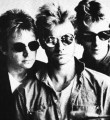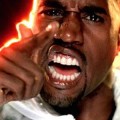The Making of Heavy Metal Parking Lot
A favourite on Nirvana's tour bus, the legendary Heavy Metal Parking Lot documents a group of heavy metal music fans before a Judas Priest concert in 1986. The makers reveal how it was made.
£6.66 per hour. Free on Sundays
One balmy Saturday evening in May 1986, two film-maker geeks staked out the parking lot of a Largo, Maryland concert arena with a borrowed video camera the night that hoary, rock gods Judas Priest came to town. They came away with a cult movie called Heavy Metal Parking Lot.
John Heyn and Jeff Krulik’s original intention was to simply go out and interview the denizens of the lot. “We envisioned there would be bikers there and drug deals going down on the periphery of the parking lot,” says Heyn. “And thought that if we turned up there with our camera, they’d think we were narks and kick our asses and break up our equipment. But that didn’t happen.” Instead they stumbled upon a subculture of archetypal teenage rock fans engaged in an age-old custom: the tailgate party.
According to tailgating lore, the first such party occurred at a college football game at Yale in 1904. Private railcars bringing spectators to the game dropped them off some way from the stadium, leaving them tired and hungry by the time it came to kick-off. Thereafter, spectators brought picnic hampers packed with liquor, meat and fatty snacks and pitched-up outside the arena to chow-down. A pre-game ritual was born! The name ‘tailgating’ dates from even earlier: at the very first college football game, between Rutgers and Princeton in 1869, fans grilled sausages and burgers at the ‘tail’ end of their horse-driven carriages.
Fast forward to 1986. Heyn and Krulik weaved their way through a crowd of metalhead teens gathered in groups around their vehicles. They spent two hours in the parking lot, shot an hour’s worth of material and cut it into a sixteen minute documentary. The rest of the footage, says Heyn, was largely unusable. “We would forget to turn the camera off and point it at the ground for several minutes.”
Cranked-up on weed, cracking beers from coolers in the popped trunks of their cars, the heavy metal fans were psyched to be interviewed on TV. The two man crew claimed to be from MTV. “It was the easiest option,” says Heyn, “because when we explained that we were making a documentary, the usual response was ‘What’s a documentary?’. They weren’t that well informed and we wanted to get right to the questioning.”
Heavy Metal Parking Lot is a film that benefits from repeat viewings. “People have memorised lines of dialogue from this movie,” says Heyn. “After a while, the characters grow on you. People identify with them or just find what they say is so funny and outrageous.”
“We found all these middle-aged women hanging out and partying,” says Heyn, “but not to the same extreme; although, they lusted after their idol even more than the heavy metal fans. These women were jonesing for Neil Diamond.”
Among the characters that leap out are Zebra Man, a loud-mouthed, teen with crimped hair in matching black and white striped spandex pants and cut-off t-shirt. He snatches Krulik’s microphone and, apropos of nothing in particular, launches into an anti-punk rock rant. “Heavy Metal rules, punk rock sucks, Madonna can go to Hell. She’s a dick,” he screams in a stream of booze-fuelled verbiage. Another long-hair teeters on the tarmac, bare-chested and with bottle in hand, identifying himself in a short-but-seminal piece of dialogue. “What’s your name,” asks Krulik. “Gram, man,” replies the droopy-eyed teen, “like Gram O’ Dope.”
Girls confess their longing to jump Priest frontman Rob Halford’s bones, oblivious that his predilection for sporting studded leather and fitted jockstraps was inspired by butch queens rather than hells angels. Pumped-up youths lean provocatively against their sleek-bodied cars. They wear tight-fitting tees emblazoned with death’s head logos and war-mongering slogans such as ‘If You Can’t Beat Them, Nuke ‘Em!’ and ‘Kill ‘Em All’. Their jailbait girlfriends sit obediently in the front seat, bobbing to classic rock blaring from the stereo.
The film is a time capsule of not only ‘80s metal – the fans, the fashion, and, above-all, the hair – but also of a defining moment in American car culture. The 1980’s marked the dying days of the muscle car, the small, souped-up ‘70s cars with high-powered, fuel-injection engines favoured by suburban youth. Pontiac Firebirds, Trans-Ams, Chevy Impalas, Corvettes, Camaros. Loud and fast metal stallions ridden by hard-rocking kids. These vehicles were often acquired by teenagers as hand-me-downs from their parents or grand-parents, given customised paint-jobs and fitted with chrome hubs.
The muscle car era began in 1964 when Pontiac engineer John DeLorean over-ruled an internal General Motors mandate (not to produce high performance cars for stock-car racing) and fitted the lightweight body of a Pontiac Tempest with a 6.4 litre V-8 engine. It was renamed the Pontiac GTO after Ferrari’s early 60s, small run sports car. Sales projections for the GTO were shattered three times over with over 32,000 cars shipped in the first year of production. Pontiac owners began to proudly refer to the cars as the ‘Goat’. Other manufacturers swiftly followed suit producing their own high performance models at ‘blue collar’ prices. The muscle car proved immensely popular with kids addicted to noise and speed.
“American youth feel complete when they’re with their cars in a parking lot,” muses Heyn. “The lot brings a large number of people into a public space but, nonetheless, creates an intimate setting where they can be themselves. It acts as a focal point or vortex. All roads lead to the parking lot. And for these heavy metal fans it’s like the centre of the universe, a mecca” he continues, warming to his theme. “Right in the middle of this large expanse of asphalt sits a giant concert arena, a place of worship for their Metal Gods.”
Heyn, who currently works as a video producer at the Washington Veterans Medical Centre, and Krulik, now a freelance TV producer, have never seen much money from the film. But, distributed for the most part on bootlegged tapes, it took on a life of its own. Celebrity fans include Edward Norton, John Waters and Dave Grohl – a tape of HMPL was a permanent fixture of the Nirvana tour bus – but not, apparently, Judas Priest themselves. “In 1988, we went back to the same venue and handed copies of the tape to their manager,” says Heyn. “We never heard back from them but clips from our film turned up on one of their official videos. [Singer] Rob Halford will neither confirm nor deny that he has seen it.”
The film is a time capsule of not only ‘80s metal – the fans, the fashion, and, above-all, the hair – but also of a defining moment in American car culture.
In recent years, their short film has also inspired a Hollywood movie (‘Rock Star’), music videos and its own franchise of imitators (which include ‘Spice Girls Parking Lot’ and ‘Raver Bathroom’).
Buoyed at the initial response, Heyn and Krulik decided to continue their exploration of pop anthropology, returning ten years later to film a sequel in the same parking lot. This time they crashed the pre-concert knees-up of a group of rabid Neil Diamond fans. “We found all these middle-aged women hanging out and partying,” says Heyn, “but not to the same extreme; although, they lusted after their idol even more than the heavy metal fans. These women were jonesing for Neil Diamond.”
Heyn also produced ‘Monster Truck Parking Lot’. “A lot of those people come from the same strata of American society as the metal fans,” he says. Meanwhile, Krulik mingled among children and parents turned-out in fancy dress and lined up outside a bookstore for a J.K. Rowling signing ‘Harry Potter Parking Lot’.
The duo are currently putting together a DVD release of Heavy Metal Parking Lot which will include, the original film plus lost footage and several tribute films. The plan is to track down characters from the original with the intention of filming a reunion in the very same parking lot.
They have also scripted a feature-length comedy based on the film – pitched as “Mr. Smith Goes to Washington” meets “Rock n’ Roll High School”. They also plan to capitalise on the vogue for reality-based shows by turning the original premise for HMPL into a TV series touring parking lots across America, a format ready-made for endless variations on the same theme.
“We’re just happy that Heavy Metal Parking Lot has taken on a life of its own,” says Heyn. “It just seems to keep rolling as other generations discover it. But we would like to see a pay-off, because we’re still here, poor and broke.”
‘Heavy Metal Parking Lot’ tapes and merchandise are available here.
Krulik and Heyn’s films can be previewed online here
Click here for more Music stories
Click here to follow Sabotage Times on Twitter
Click here to follow Sabotage Times on Facebook


 RELATED
RELATED




 COMMENTS
COMMENTS SABOTAGE
SABOTAGE





